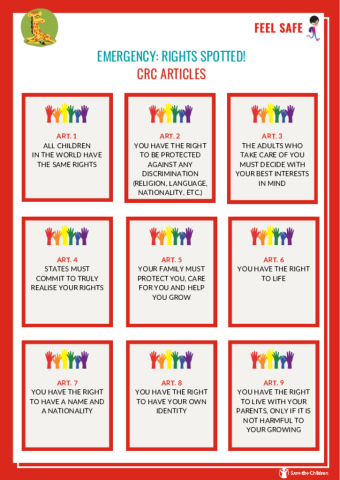Emergency: rights spotted!
Objectives:
- Get to know the articles of the CRC (Convention of the Rights of the Child)
- Reflect on the importance of safeguarding the rights of all before, during and after emergencies
STEP BY STEP
BEFORE STARTING
We introduce the activity by talking about the CRC, the UN Convention on the Rights of the Child, adopted by the UN General Assembly on 20 November 1989.
More information about the CRC can be found at this link.
The teacher asks the class to read the CRC, which can be viewed here. Copies can be handed out or articles can be read in turn.
WHERE ARE THE RIGHTS?
The teacher divides the class into small groups. Each group is given post-it notes in different colours. With the help of the teacher, each group writes down a series of places familiar to the children (home, school, hospital, public gardens, gymnasium, etc.) and the things that can be done in these places (study, learn, eat, sleep, care, play, have fun). Different sheets will be used for each place and for each action.
For each group, the teacher cuts out the articles of the CRC in the attachment "Emergency rights spotted - CRC articles" (blow) and places them on the teacher's desk for the pupils along with tape.
The teacher then calls a place and, in turn, each group chooses a right and associates it with the place and the actions that can be performed there, explaining the reason for the choice (e.g. I associate the right to study with the school because for me it is the place where I learn).
RIGHTS DURING EMERGENCIES
Here we reflect on the changes brought about by a sudden emergency and how the enjoyment of rights can also be threatened. Which rights, in your opinion, are most 'damaged' in the event of a major natural disaster? Each group can reason about the rights they consider most 'vulnerable' and write them down on a sheet of paper.
To encourage reasoning, the teacher can propose a series of scenarios that can refer to the specific context of their area or can use the proposals below:
Scenario 1: An earthquake Sudden ground shaking resulting from movements of the earth’s crust hits my community and my school is heavily damaged.
Scenario 2: The public gardens where I meet my friends are no longer usable due to a strong whirlwind and are closed.
Scenario 3: A flood hits my town. roads are impassable and there are severe rationing of food and water.
THE BACKPACK OF RIGHTS
After collecting the answers from each group, construct their own backpack of rights. You can use a backpack where you symbolically place all the rights you want to take with you in an emergency. The rights can be represented as drawings or written on cards or the rights cut out from the CRC used in the first part of the activity can be reused. Once the backpack is composed, each group tells the rest of the class about their choice of rights in their backpack.
CONCLUDING THOUGHTS
What can be some solutions so that in emergencies one continues to enjoy rights that would otherwise be violated? For example, how do I continue to study? To see my friends? Together with the teacher, the class can define some strategies to ensure that children's rights are respected in an emergency.

Add new comment